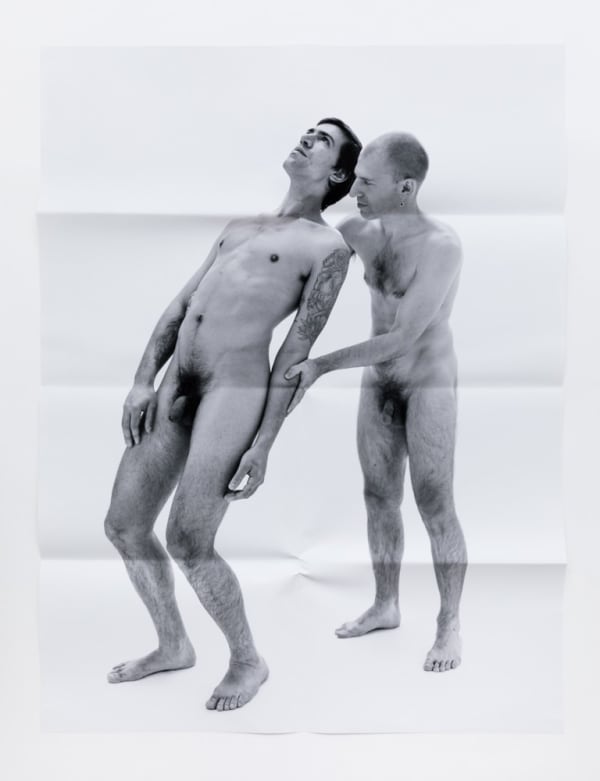Jack Pierson
Like a monument made of crepon paper and silver
Exploring the sidewalks of São Paulo’s Avenida Paulista, Jack Pierson brought to life his first solo show in Brazil entitled You Don’t Own Me, a nod to Lesley Gore’s 1963 song. He asked street vendors to purchase their stands, their entire system of livelihood – from the canvas on the ground to the chairs where they sat, to the carrinhos de rolimã (roller carts) and craft jewelry being offered for sale. Now, he is meticulously recreating these displays – framing the objects on the wall or exactly as they would have been laid on the streets – in the space of a gallery, obscuring the lines between art and commerce.
Though this is a new project for Pierson, he is no stranger to working with a variety of materials that are charged with dichotomies of memory and unspent potential. His extensive use of discarded objects has burgeoned into a variety of mediums including photography, sculpture, drawings, collages, video, and artist’s books. Repurposing everyday articles for art, of course, harkens back to a Duchampian platitude, but Pierson moves far beyond the isolation of object from functional context. The recreations of the Avenida Paulista stands emphasize his desire to remove the singular focus on immediate tactility and assert the emotive ambiguity that remains. The reconstructions, in conjunction with three new sculptures, emphasize a paradox of the materials’ inherent nostalgia and the joy of a new purpose.
An iconic element of his practice, Pierson collects abandoned letters from closed businesses like cinema marquees, casinos, or storefronts, road signs and other cultural ephemera. The recyclable element of these sculptures seamlessly reinforces the role of materials in this show. The namesake letter sculpture, reading You Don’t Own Me, unabashedly confronts the issue of authorship and originality. The pairing of two words Endless Supply tackles the questions of infinite supply and demand and the bonds established between consumers and objects. Another sculpture singles out the letter O, the most frequently discarded letter of the alphabet according to the artist. This abundance of Os leads to inventive structures that formally play with the shape of the letter, which is echoed in some of the craft jewelry here displayed. The O also brings to mind the universally mystical elements and sacred meanings associated with a circle.
Pierson’s personal involvement in the role of the vendor began in his youth. As a teenager in Plymouth, Massachusetts, he frequented thrift shops as well as made and sold his own jewelry in the local flea markets. After moving to Manhattan in the 80’s, he continued his relationship with sidewalk salesmen through nightly visits to the now gentrified Astor Place in the Lower East Side. At the time, these two or three blocks were lined with the quintessential vendors bringing found objects to sell and infusing character to the street. His repetitive visits gave him eyes to not only see their offerings, but to unveil traces of their previous owners. These items were not just pieces of the commercial activity we partake in, but objects with a past, present, and future.
Pierson’s new works blur the lines of art and commerce by creating a lifetime for the objects that would not have been possible without him. Each object is no longer a fleeting piece of commerce, a victim of here today, gone tomorrow, but immortalized in a single work of art as a still life. Furthermore the reconstructive nature of the displays challenges the intrinsic notion of display authority alive in any gallery, museum, or art institution. The presentation of these sculptural works is dictated not by the artist or even the institution, but by the vendors themselves. Whatever price Pierson paid for each stand, the commercial value will be redefined to the standards of the art world. The sidewalk value of each stand will no longer exist, only the value of Pierson’s artistic realization.
Helplessly Hopeful
I met Jack Pierson in the early 1990’s, in New York City, where I live. I don’t quite remember the circumstances under which we met, but I do vividly recall the time I saw his work at Tom Cugliani’s Soho gallery and the effect it had on me. In downtown Manhattan, a sense of chaos had materialized overnight as life after AIDS came with many questions that were not easily answered. A group of artists took to the front lines of the war against the epidemic and Jack was one of them. At Cugliani’s, one of the works that I will never forget was formed by a group of mismatched letters Jack had salvaged from the many businesses closing in Times Square. The letters spelled out Hopeless and Helpless in the shape of an X, intersecting at the letter P, perhaps an insertion of the artist’s identity. The work poignantly addressed the emotional state of our generation in a simple, matter-of-fact way. It was infused with feelings of melancholy, absence and vulnerability.
Acknowledgments: Kelsey Richards e Izhar Patkin
Jack Pierson was born in 1960 in Plymouth, Massachusetts, and graduated from the Massachusetts College of Art in Boston in 1984. He lives and works in New York. Pierson’s recent solo exhibitions include CAC Malaga; Irish Museum of Modern Art, Dublin; Galleria Christian Stein, Milan; Regen Projects, Los Angeles and Cheim & Read, New York. His work is part of the intitutional collections of the Metropolitan Museum of Art, the Whitney Museum of American Art, the Solomon R. Guggenheim Museum, NY; the Museum of Contemporary Art, Los Angeles and the San Francisco Museum of Modern Art, among other museums worldwide. Pierson is represented by Cheim & Read, New York.
– Nessia Leonzini Pope

















